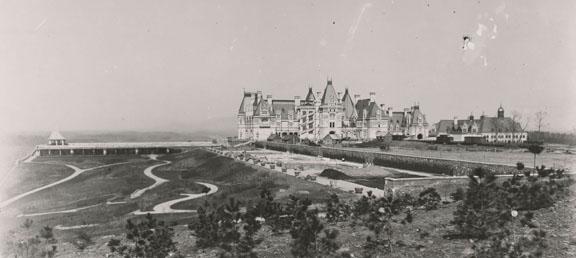A new exhibit at Antler Hill Village on the grounds of Biltmore Estate near Asheville, N.C. examines a legacy in drawings and photos from three of the brighter lights of late 19th century design.
The collaborative efforts in the Carolina mountains by Frederick Law Olmsted, Richard Morris Hunt and George Vanderbilt left behind more than a beautiful French Renaissance home in the American style. The trio also gave us an instructive treatise on how to live comfortably on the land while sustaining it for future generations.
Once he’d purchased thousands of acres in rural Carolina in the 1880s, George Vanderbilt turned to master land planner Olmsted for advice about what he should do with it.
“Olmsted saw the possibilities and became a mentor,” saysEllen Rickman, director of museum and guest services at Biltmore. “He laid out in a document an overall vision for the estate with a home, some formal gardens, a farm, and forestry. He suggested that George had the opportunity to do something meaningful – to make it a learning laboratory for sound practices in land management.”
Vanderbilt, an intellectual by nature and a lover of art and architecture, had already worked with Olmsted and Hunt on his family’s mausoleum on Staten Island. Hunt had designed for him also the first totally free library in New York, known not by the Vanderbilt name, but as the Jackson Square Free Circulating Library. So it’s no surprise that he would turn to Hunt to design his new estate.
Their relationship transcended that of architect and client. Hunt travelled in the same Newport social circles as Vanderbilt, and was almost like family. Indeed, after Vanderbilt’s father’s death in 1887, Hunt stepped forward to fill the void. He took him to Europe as they sought out inspiration for his new residence, and shopped for the accoutrements that would furnish it.
The trio would join forces in Asheville for a tour de force. “They may have clashed in the past, but they came together here to create something with lasting meaning,” she says. “Olmsted told his workers that long after they’d be gone, this would still be here, so they had to get it right.”
Getting it right meant more than just exquisite design for the house and grounds, though they certainly achieved that. (Hunt’s wife once wrote that ‘This isn’t Newport – this is something grander. This is a house to fill the scale of the mountains.’) To this trio, getting it right meant leaving a legacy for the nation.
Hunt brought to the table a broad knowledge of French and British architecture, to be sure. But he also turned Biltmore into a demonstrable exhibit of state-of-the-art technological systems for heating, plumbing and electricity, at a time when pride in all things American was paramount.
In addition to planning and managing the landscape, Olmsted restored thousands of acres of trees. He laid out the first sustainable forestry program in the nation. Then he established its first school for foresters.
Vanderbilt brought his own progressive attitudes to Asheville. He hired African Americans and integrated them into the work force that built his estate – an unheard of practice at the time. He built a kindergarten for his workers’ children. And he agreed to finance the equivalent of a YMCA for Asheville’s black community.
“George didn’t want to be just a rich man with a beautiful house,” she says. “He wanted to make a difference here.”
Richard Morris Hunt would die in 1895, the same year that Biltmore opened. About that time, Frederick Law Olmsted would develop dementia, and live only through the early 1900s. George Vanderbilt would die of complications following appendicitis in 1914.
But today, this trio’s thoughtful legacy of a working estate and managed forest is open to the public twelve months a year – a living laboratory for a sustainable world.
For more, go here.
[slideshow id=131]


